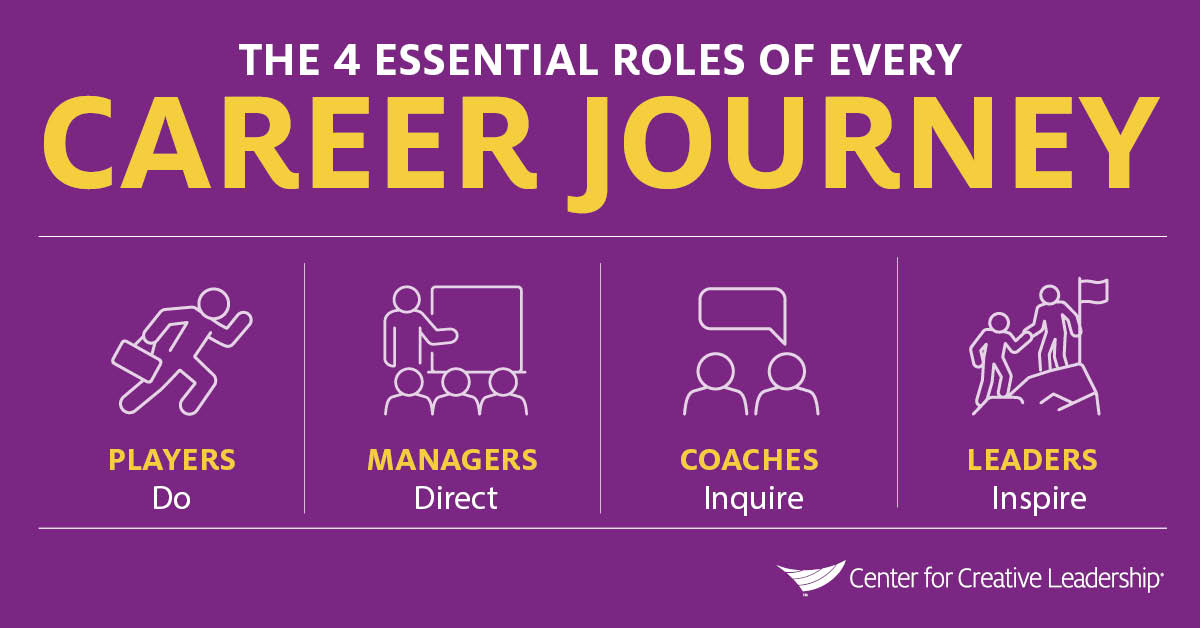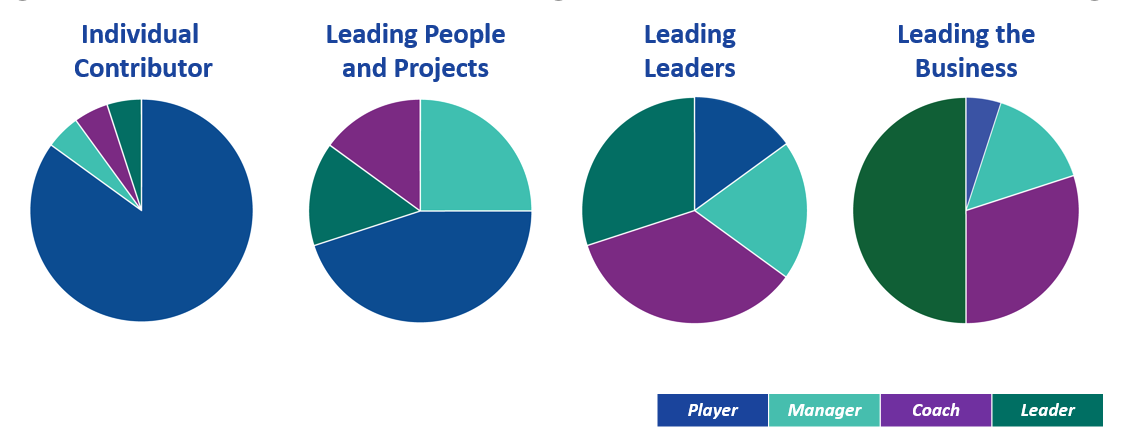Successful Professionals Understand These Leadership Roles & When to Play Each One
As people, every role we play has certain responsibilities and skills that come with it. And as we all know, each of us plays multiple roles.
In our personal lives, this usually feels natural. We may play the roles of both parent and child, sibling, friend, and more. We lean on what we’ve seen from our upbringing and what we learn from our culture, peers, and partners. Generally, we know which role to play in which situations.
But what about our professional lives? Very often, we have a professional qualification or specific area of expertise — engineer, accountant, project manager, doctor, teacher, etc. As our careers progress, we often add or change titles — Specialist, Manager, Leader, Director, Vice President, etc. We have a job description and things to be achieved in that leadership role.
Our work with leaders across the globe for over half a century has led us to a seemingly simple, but crucial insight: We must play multiple leadership roles in our professional lives, irrespective of our qualifications or industry.
And perhaps the roles most crucial for our long-term success aren’t the ones listed on job descriptions, but those needed to make leadership happen in our organizations.
The key comes in our ability to play each role and to choose the right leadership role for any given situation.
The 4 Leadership Roles a Successful Professional Must Play
Essential Roles of Every Career Journey
At CCL, we believe there are 4 leadership roles that every professional must navigate and draw upon to be successful. These 4 leadership roles are:
- Player
- Manager
- Coach
- Leader
Player
Players are individual contributors who are vital to achieving the goals of an organization. They are the “doers” who create value by making the product or providing the service.
Regardless of our formal role, all of us keep the Player in the mix of leadership roles we need to play to contribute to our organizations. Any time we’re focused on our own performance and getting things done ourselves, we’re in the Player role. Even in the C-suite, there are times where it’s important to “just do it.”
Manager
When you manage people or projects, you need to learn to step back from doing all of the work yourself. A Manager is the one responsible for organizing the work, driving efficiency, holding people accountable, and helping get problems solved.
Like the Player, the Manager role is focused on performance, but they need to get things done through others. This is all about the mindset shift that we like to call going “from Me to We.” And it’s one of the hardest ones a professional has to make throughout their leadership career.
Coach
While we all know what an individual contributor is, and many of us carry a title with the word Manager, the Coach role is just as critical when we want to enable leadership across individuals and teams. While the Player and Manager roles are focused on performance, the Coach is focused on development.
The Coach role is not about solving the problems, it’s about helping people get out of their own way so they can become better problem solvers. Coaches are trying to bring the best out in people, trying to get people to activate their strengths. They listen, ask powerful questions, and help grow capabilities over time. Make sure you understand what it takes to coach your people.
Leader
Management is about doing things right, but leadership is about doing the right thing. Regardless of job title, when you act in the Leader role, you see the big picture and connect the dots — for yourself and others. Like the Coach, the Leader is about development. But Leaders are not just developing individual capabilities, they’re looking at the whole system.
They’re influencing others and taking actions to develop the collective capacity for direction, alignment, and commitment (DAC), because when there’s shared DAC, leadership is happening. That’s how leadership works.
Consider the Leadership Roles You’ve Played in Your Own Career Journey
You may want to pause for a moment to consider your own current professional responsibilities and reflect on the leadership roles you’ve played in your own career journey.
- How do you currently divide your time between these 4 leadership roles?
- How has that changed over time?
- How comfortable and capable do you feel in each leadership role?
- What leadership roles might you need to play more (or less) frequently in the future to be even more successful in your career journey?
When Is Each Leadership Role Typically Played?
How Leadership Roles Vary by Leader Level & Career Stage
At every stage of your career, you’ll be required to play each of these leadership roles, but what we tend to see is that the ideal ratio among the roles changes, as you move through different levels of leadership. As we’ve worked with leaders around the globe, we’ve found that there are some predictable shifts in the amount of time you’ll need to spend in each role in order to be most successful.
While the ideal ratio of time spent in each leadership role varies a little from one industry to another, and from more matrixed organizations to more traditional ones, what we tend to see looks like this:
- Individual contributors and professional staff need to coach, manage, and lead occasionally, as in order to get things done, they must be able to influence others without formal authority. They are typically in the leadership role of player over 3/4 of the time.
- Those leading people and projects will still spend nearly half of their time in the role of player, but also a significant amount of time as manager. They will need to be a coach to, and leader of, other people in about equal parts in order to get their work done.
- Those leading other leaders will spend the most time in the roles of leader and coach, with less of their time spent managing others, or doing the work themselves.
- Executives in charge of the entire organization, business, or function typically spend as much as half their time in the role of leader and 1/3 of their time in the role of coach.
Shifting Into New Leadership Roles Can Be Challenging
Our work with leaders at all levels globally has also shown us that the hardest transition to make is often from individual contributor into the leadership role of manager who is leading people or projects.
The graph above is a great way to see why that jump into management tends to be so hard. Individual contributors are typically in the role of player about 90% of the time. When they’re asked to become responsible for the work of others, they must make a significant shift in their mindsets, skillsets, and toolsets in order to play the other leadership roles far more often and more skillfully. But many struggle to show trust in their teams with delegation.
This is especially common among new frontline managers, because as many as 50% of new managers are rated as ineffective in their roles, and 40% fail within the first 18 months. When this large population of leaders struggle, this carries a huge cost for organizations.
But luckily, there are ways to support new managers of people and projects and set your first-time leaders up for success so they’re ready for their new leadership roles, and providing them with support such as coaching and mentoring programs for new leaders.
Learning new mindsets and skillsets are like any other pursuit. You wouldn’t want to teach yourself to skydive without expert instruction; it’s the same with leadership skills.
We can support you and your organization’s leaders to help with the development of competencies needed to succeed in all the leadership roles played throughout their career journeys.
Ready to Take the Next Step?
As you and your team grow in each of the 4 leadership roles and strive to move your organization forward, we’re here to help. We offer award-winning programs to address the different challenges that new leaders in particular face. Explore our frontline and new manager courses.
“CCL’s program helped me assess my role and contribution as a player, manager, coach, and leader. I feel more equipped to serve my team and organization in all 4 of those capacities and look forward to continual personal growth as I continue to reach my leadership potential.”
Manager — Talent & Organizational Development
Serco Inc.
Maximizing Your Leadership Potential Participant













